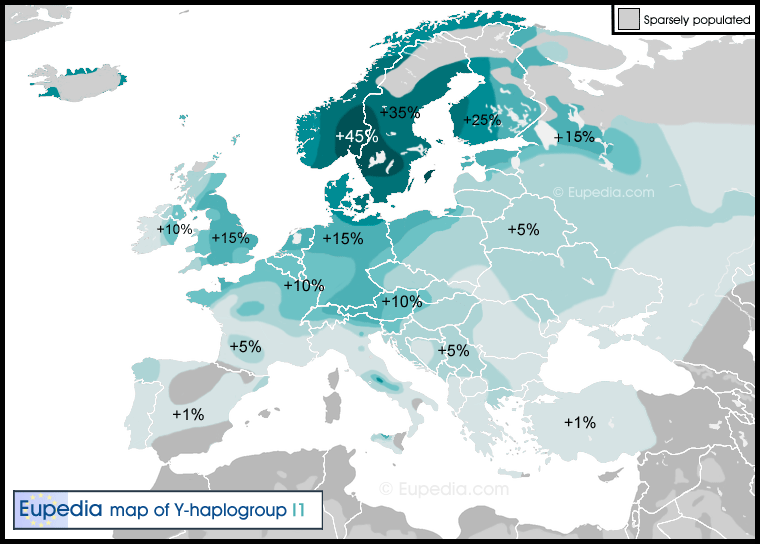I have revised my map of haplogroup I1, adding a new category of colour for regions with 1 to 5% of I1, so as to distinguish them clearly from those with under 1% of I1. I have also added the hotspots around Slovenia, Macedonia, Central Ukraine, and northern Sicily.
I was able to give a more accurate representation for Sicily and Crete thanks to the more detailed studies of these islands by Di Gaetano et al. 2009 (Sicily) and Martinez et al. 2007 (Crete). The eastern part of both islands completely lacked I1.
Iberia is one of the most difficult part of the map. Whereas the Asturias, Galicia, Portugal and Extremadura have undeniably more than 1% of I1, and the Basque country, northern Castilla, Murcia and Andalusia less than 1%, I have conflicting data for Castilla-La-Mancha, Valencia and Aragon. Adams et al. give about 5% of I1 in Aragon (n=34), but Iberianroots gives 0% (n=74). In Valencia, Adams et al. reported 2.2% (n=73) of I1, but Iberianroots still has 0% (n=77). In Castilla La Mancha, Adams et al. has 0% (n=63), while Iberianroots has 2.6% (n=77).
Please let me know if you notice any possible errors (and please provide link to studies that contradict the data, not just hearsay or personal opinions). Keep in mind that the map remains quite approximate.

I was able to give a more accurate representation for Sicily and Crete thanks to the more detailed studies of these islands by Di Gaetano et al. 2009 (Sicily) and Martinez et al. 2007 (Crete). The eastern part of both islands completely lacked I1.
Iberia is one of the most difficult part of the map. Whereas the Asturias, Galicia, Portugal and Extremadura have undeniably more than 1% of I1, and the Basque country, northern Castilla, Murcia and Andalusia less than 1%, I have conflicting data for Castilla-La-Mancha, Valencia and Aragon. Adams et al. give about 5% of I1 in Aragon (n=34), but Iberianroots gives 0% (n=74). In Valencia, Adams et al. reported 2.2% (n=73) of I1, but Iberianroots still has 0% (n=77). In Castilla La Mancha, Adams et al. has 0% (n=63), while Iberianroots has 2.6% (n=77).
Please let me know if you notice any possible errors (and please provide link to studies that contradict the data, not just hearsay or personal opinions). Keep in mind that the map remains quite approximate.

Last edited:

